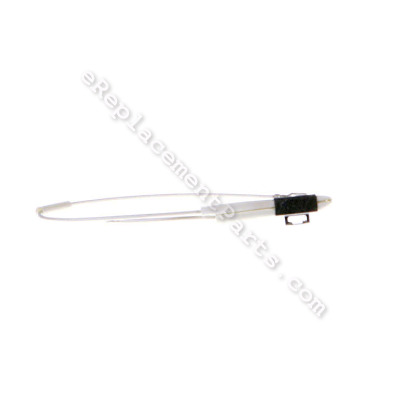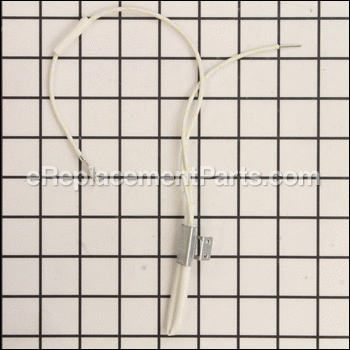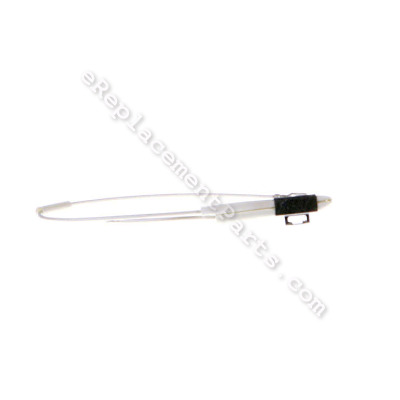Fuse Assembly SP0010484
OEM part for: Breville
Part Number: SP0010484
Compatibility
This part will fit the following 1 machine
Breville
This item works with the following types of products:
- Oven Parts
This part replaces obsolete part #: BOV450XL/63, BOV450XL63
Customer Part Reviews ?
- 1
Questions & Answers ?
Our customer Service team is at the ready daily to answer your part and product questions.

Ask our Team
We have a dedicated staff with decades of collective experience in helping customers just like you purchase parts to repair their products.
Does this fit my product?Questions & Answers for Fuse Assembly
Customer Repair Instructions ?
All our customer repair instructions are solicited directly from other customers just like you who have purchased and replaced this exact part.
Stopped working totally
Tool Type
Toaster
Difficulty
Medium
Time
30-60 minutes
Tools Used
Screwdriver
Parts Used
2. Peeled outside back, removed more screws
3. Replaced fuse after cutting all plastic ties
4. Put tons of screws back on.
Thermal fuse blew out
Tool Type
Convection Oven
Difficulty
Medium
Time
1-2 hours
Tools Used
Screwdriver, Pliers, Electrical connector crimper and wire cutters/strippers.
Parts Used
The fuse blew out, hard to believe on a 2+ year old Breville Mini Smart Oven, My old GE still working after 30 years
Tool Type
Toaster
Difficulty
Medium
Time
1-2 hours
Tools Used
Screwdriver
Parts Used
Had a hard time changing out fuse assembly which was difficult because we could not take off the entire back and had to work in a small space. Manufacture did not make it easy to repair.
It was worth effort as oven is now working and saving over 200$ with a 10$ part.
Just wouldn't turn on all of a sudden.
Tool Type
Convection Oven
Difficulty
Medium
Time
More than 2 hours
Tools Used
Screwdriver, Wire cutter and stripper
Parts Used
It took a while just to remove the 41 screws while trying not to strip the threads. The toughest part was to slide the back panel off after all the screws were removed and not clear which part exactly to replace. I'll list the tips below.
1. Remove all screws at the back panel and the 4 feet as well as the side screws at the bottom panel. The two front feet have two hidden screws under the oblong rubber. The two back feet have a revel that cannot be removed, that is, they won't completely come off.
2. Remove the front feet and loosen the back feet. Wiggle the side panel (where all the controls are) to open enough space to slide off the back panel. I found it easier to rotate the back panel counterclockwise to get it off. I didn't warp any of the sheet metal.
3. Unscrew the 2 screws that hold the bracket that hold the fuse assembly. These are the only two screws inside the oven on the divider facing the oven. Remove the wire from the bracket and slide off the housing tube to expose the fuse , which is what needs to be replaced. ( I wasted a lot of time here thinking that I had to trace the wires and to replace them at their connection points and ended up cutting off all the ties for nothing). There maybe a way to replace the fuse at the original connection points, but I just cut out the bad fuse and connected the two ends of the new fuse to the old wire by using wire nuts. Place wire and fuse and bracket together as you found them.
4. Plug the oven in to see if it worked. If not, check all connections, if it still won't work, maybe fuse is not the problem.
5. If the oven comes back alive, you can spend the effort to put all parts back the way they were.
This fixed my oven!!!
Fuse failed (oven wouldn't turn on)
Tool Type
Convection Oven
Difficulty
Hard
Time
More than 2 hours
Tools Used
Screwdriver, Pliers, wire snipper and crimper
Parts Used
1. I removed the screws from the back, feet (including those hidden under the rubber tabs), and the two on the bottom side panels. I sketched a diagram and numbered the location of each screw. Then I numbered the cups of egg cartons and used them to keep the screws etc. in order.
2. I slid off the back panel.
3. I removed another screw on the bottom left side that is accessible through a hole in the metal edging. That allowed me to pry open the panel housing the wires and circuit board.
4. I clipped off the wire ties.
5. I left the fuse mount in place, but pried it open to remove the fuse.
6. I unplugged the fuse from the 2nd slot in the circuit board as described by another user: "On the plug you'll see how those two curled pieces of the fuse end are on the plug. Using a very small screwdriver very gently insert it into the little opening in the plug. You want to open the fuse end a tiny bit so it can be pulled off the plug."
7. I un-crimped the fuse cap that held the other end of the fuse together with the power cable following the instructions of another user: "First grab some needlenose pliers or other instrument that lets you crimp down on the cap in the opposite way it was crimped. Picture a + sign. There's top and bottom, and left and right. If it was crimped in the top/bottom way, you'll want to squeeze the left/right way."
8. I plugged one end of the new fuse into the second slot on the circuit board.
9. I twisted together the wires from the other end of the fuse with those of the power cable, inserted them back into the fuse cap, and re-crimped it closed.
10. I taped together the fuse with the other wires so that they're held in the middle of the wire compartment, not touching any of the oven walls.
11. I cleaned as much of the oven as I could.
12. I screwed back in the screw underneath the wire compartment. This helped hold the structure of the oven steadier for the next step.
13. The metal panels of the oven had come un-clipped from wires around the edges of the frame. I re-inserted them the best I could so that I could slide the back panel in again. This was difficult and took a long time, because the metal panels had become slightly warped when I opened up the oven to access the wires.
14. I reinserted all the screws and feet.
This is the first fuse I ever replaced. I have no experience with anything electrical. This was hard and took a long time, but it was do-able, and my oven works well again! I also agree with what other users said -- now that the fuse isn't touching the hot interior oven wall, I expect it to last a long time.
Start button did not turn toaster on
Tool Type
Toaster
Difficulty
Easy
Time
30-60 minutes
Tools Used
Screwdriver, Pliers
Parts Used
-Unscrewed 2 screws on bracket holding fuse assembly replacing with new assembly.
-cut wires from crimped wire nut then stripped end of black wire. Connected black wire to white wire with wirenut.
-cut all tire wraps. Followed 2nd white wire to connector. Unplugged and plugged new wire in. Was a very tight work space.
-replaced wire ties to hold wires together.
-carefully slid back on…..put feet on then all other screws.
- recommend taking pictures as you take apart. Helps when putting back together.
My Breville 450 toaster oven just died mid-use (fuse blew)
Tool Type
Toaster
Difficulty
Medium
Time
30-60 minutes
Tools Used
Screwdriver, Pliers
Parts Used
But hey, you're here so that's a good sign that you're looking to do this the right way.
What I used: 1 long (12-16' philips screwdriver) helpful for reach the deep in screws from step 9; 1 shorter ratcheting screwdriver (philips) to help with screwing so many screws in; 2 flat screwdrivers (one tiny, that I could squeeze into the little holes at the one of the fuse assembly, and a second wider one for helping push the fuse assembly down on to the circuit board); painters tape for keeping the door shut; needlenose pliers for crimping a wire cap
1.) first thing is take all the screws off the back and gently slide the back off. You will have to unscrew the back feet, as well as the front right foot of the machine (the one under the buttons). There are two 'layers' of screws so once you remove the ones you can see, pull the tab out of the middle and you'll see a screw or two remaining. This threw me off for a sec on the front right one.
2.) Your toaster's outer layer is metal and so while you can bend it out of place to get around it, just be a bit gentle since it may stay bent when you go to put everything back together. You'll just have to fight to push it into order again which is not much work at all. Just a heads up.
3.) Looking at the back of the toaster, with the back off, everything you need to focus on is on the left side. Pretty quickly you should find the fuse covered by a white tube.
4.) Remove the fuse from the mount. Not necessary, but you may want to remove the mount since it's on the sidewall taking all the heat from the unit. If it really is a heat sensitive issue with the fuse going, you may want to attach the mount elsewhere (or not even use it) once you have the new fuse in there. Just so it's not resting up against all that heat.
5.) When you have the fuse pulled loose from the mount, you'll see one side goes into a cap with a wire from the power cable. The other side goes down into the unit towards the front and plugs into a circuit board.
6.) Trim all the plastic ties so the wires are more easily accessible.
7.) How to replace the fuse, simply find the open end of your new fuse, the one with the exposed wire. That goes in the cap with the black power cable end. The other end simply plugs into the circuit board up front. It is the second connection from the left in the circuit board. The left most plug will say "null" above it. The one we care about is just to the right of it and it says "life".
8.) Replacing the 'cap' end. First grab some needlenose pliers or other instrument that lets you crimp down on the cap in the opposite way it was crimped. Picture a + sign. There's top and bottom, and left and right. If it was crimped in the top/bottom way, you'll want to squeeze the left/right way. This should open it up a bit to allow both the old fuse wire and the power cable wire to come out. You don't need the power cable wire to come out, but generally I like to twist the two wires together to ensure a good connection before using such a cap but it'll work if the power cable stayed in. Once the old fuse end is out, you can put the new one in. Again, if you just squeezed the left/right direction, now you want to squeeze top/bottom to close it back up. Gently tug on the cap to see if it's crimped on there well. If it is, great job. If not, squeeze harder! (or just use a fresh cap!)
9.) Now the trickiest part besides finding the patience to unscrew so many screws (all that is unscrewed must then be screwed!) is the replacement of the 'plug' end of the fuse. Note: a lot of directions talk of polarity in the fuse (one side is colored black) but that doesn't really matter here because you're replacing one type of end with the same type. So you don't need to worry about that stuff and you shouldn't take the plastic sheathing off the fuse. To pull the cord out of the 'life' plug on the circuit board, you'll want some space. With the front right foot off, you'll see there is a screw halfway up and well as up in the top corner, in the space you're trying to access. If you get those off, you can sort of pull the entire side of the toaster up and away a bit so you have more room to work with. Again, don't pull too hard because it will bend and stay that way, you want to get this back to the way it was before. With the space to move now, locate the second plug in from the left at the bottom. On the plug you'll see how those two curled pieces of the fuse end are on the plug. Using a very small screwdriver very gently insert it into the little opening in the plug. You want to open the fuse end a tiny bit so it can be pulled off the plug. Imagine a number 9 and you're putting the screwdriver in the hole to try and pry it open just the tiniest little bit. Honestly, you may feel like to didn't do anything to pry it open and that will be enough. You just want enough to be able to pull the thing off. Once you've pulled the fuse end off, simply press the new one into place. It's a tight fit so take a wider screw driver and use that to push down on the fuse end as you maneuver it evenly onto the plug. In the example of the #9, you're now pushing the screwdriver onto the circle of 9 to push it on the plug.
10.) with the new circuit board end in, and the power cable end replaced, you're done. How easy was that?
11.) Now, it's a matter of screwing all the screws back in. If you bent the metal, you'll need some help pushing on one side to align the holes so you can screw it in. There's no screw up in the front, but the top meets the front with a few lips of metal, just make sure those snap back into place before you've got too much screwed back in.
12.) Also, before you have too much done, neaten up the wires a bit. You could reattach the mount for the fuse on the outside wall if you don't mind the holes on the side.
Tip: don't screw all along one side first. Treat it like replacing a tire. Place a screw on the left, then on the right, then on top, then bottom, etc... This way the thing stays square and you're not pulling everything down one way.
Convection oven would not turn on
Tool Type
Convection Oven
Difficulty
Easy
Time
Less than 15 minutes
Tools Used
Screwdriver, Pliers
Parts Used
2. Remove feet assembly
3. Remove old fuse
4. install new fuse
5. Replace feet assembly and back panel
Fuse blew
Tool Type
Convection Oven
Difficulty
Expert
Time
30-60 minutes
Tools Used
Screwdriver, Wire strippers
Parts Used
OEM stands for Original Equipment Manufacturer and means the part you’re buying is sourced directly from the manufacturer who made your product. At eReplacementParts, we sell only genuine OEM parts, guaranteeing the part you’re purchasing is of better design and of higher quality than aftermarket parts.
Our product descriptions are a combination of data sourced directly from the manufacturers who made your product as well as content researched and curated by our content & customer service teams. This content is edited and reviewed internally before being made public to customers.
Our customer service team are at the ready daily to answer your part and product questions. We have a dedicated staff with decades of collective experience in helping customers just like you purchase parts to repair their products.
All our part reviews are solicited directly from other customers who have purchased this exact part. While we moderate these reviews for profanity, offensive language or personally identifiable information, these reviews are posted exactly as submitted and no alterations are made by our team.
All our customer repair instructions are solicited directly from other customers just like you who have purchased and replaced this exact part. While we moderate these reviews for profanity, offensive language or personally identifiable information, these reviews are posted exactly as submitted and no alterations are made by our team.
Based on data from past customer purchasing behaviors, these parts are most commonly purchased together along with the part you are viewing. These parts may be necessary or helpful to replace to complete your current repair.
All our installation videos are created and produced in collaboration with our in-house repair technician, Mark Sodja, who has helped millions of eReplacementParts customers over the last 13 years repair their products. Mark has years of experience in selling and repairing both commercial and residential products with a specialty in gas-powered equipment.
This data is collected from customers who submitted a repair instruction after replacing this exact part. Customers can rate how easy the repair was to complete and how long it took. We aggregate this data to provide a repair rating that allows customers to quickly determine the difficulty and time needed to perform their own repair.





